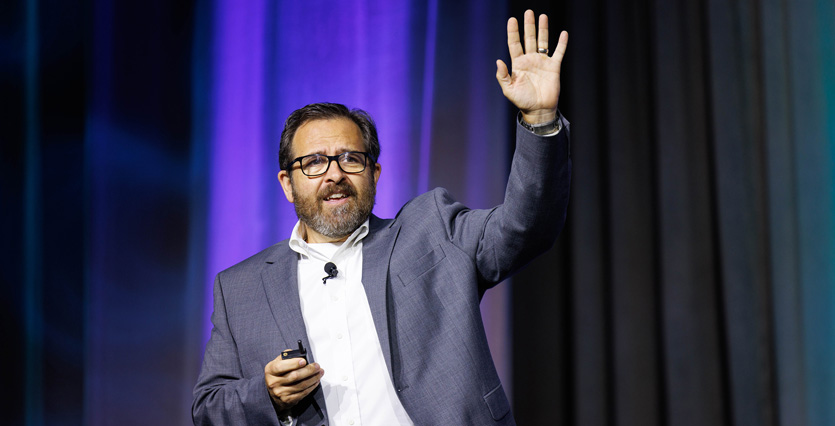


Setting the stage for our field, Malika Siker, MD, FASTRO, Medical College of Wisconsin, opened the first keynote session with a picture of our reality, as we confront and try to overcome daily attacks on our well-being. Enter Bryan Sexton, PhD, Director of the Duke Center for Healthcare Safety and Quality, who has researched solutions to this, presenting them through publications and social media accounts. His approaches are evidence-based and feasible, offering clarity and relief in our complex environment. Attendees eagerly leaned forward to learn more about microdosed interventions that we can all fit into our busy lives, implementing prioritization of our well-being.
Dr. Sexton’s expertise has its roots at UT Austin with a PhD in psychology, followed by faculty positions at Johns Hopkins University and now at Duke University. He leads the efforts at the Duke Center for the Advancement of Well-being and Science around research and training that guide our quality improvement and well-being activities. A member of the Department of Psychiatry, Dr. Sexton is a psychometrician and develops methods of improving safety culture, leadership and workforce well-being.
Dr. Sexton defined “well-being” not as our default notion of “happiness,” but rather as the ability to “do stuff.” Citing a study by Duke, UCLA and Brigham and Women’s Hospital, Dr. Sexton explained how stressed mammals exhibited the biological age to extend well beyond its chronological age. According to him, human stress is similar, and this accelerated aging has become normalized, to the point that our field has become accustomed to not just withstanding stress but testing its limit. Validating his point, the audience revealed their consensus on stressed behavior, ranging from skipping meals to sleeping less than five hours a night.
At this, Dr. Sexton presented the wisdom of Maya Angelou: “Each person deserves a day away in which no problems are confronted, no solutions searched for. Each of us needs to withdraw from cares which will not withdraw from us.”
According to a study tracking 30,000 health workers through the pandemic and after, burnout is associated with lower patient satisfaction, medication errors, and higher standardized mortality ratios. During the pandemic, physician exhaustion decreased, possibly due to seeing fewer patients, telehealth and increased time at home, while conversely, nurses experienced steadily increasing emotional exhaustion over the same period. For every point increase in exhaustion, there was a 20% greater likelihood for the nurse to step away from the bedside setting. Exhaustion is common and staffing difficult. “We don’t have gas in the tank to do heavy lifts,” Dr. Sexton said, “We need bite-sized strategies to begin to make a difference.”
All the more, understanding the “social contagion effect of well-being” is critical, as a quarter of one’s well-being is determined by surrounding company. “Burnout is a team sport,” he declared, and needs to be treated as such. Dr. Sexton shared the consequences of not addressing burnout, including multiple disruptive behaviors like workplace bullying, turning backs on conversations, and exhaustion.
However, while burnout is contagious, so is well-being. This two-way phenomenon revealed itself in a study of Notre Dame freshmen, where non-depressed and depressed roommates were paired in a dormitory. Six months into their living arrangement, depressed students became less so, and the originally non-depressed showed signs of depression.
“Your focus determines your well-being.” The true nature of well-being is not being happy all the time. It’s the ability to see the good and the bad across situations. When asked how we interpret ambiguity, the answer is determined by the state of our well-being.
Dr. Sexton cited Christina Maslach, PhD, author of the Maslach Burnout Inventory (MBI), who identified three pillars of burnout: emotional exhaustion, depersonalization and resultant callousness, and inefficacy, a diminished sense of accomplishment. “Burnout, at its core, is the impaired ability to experience positive emotion,” Dr. Sexton explained.
So, how can burnout be decreased? Dr. Sexton presented interventions that meet the diagnostic criteria for “bite-sized:” simple, brief, recovery comes quickly, and the benefits endure. Barbara Fredrickson described 10 traits of positive emotions: joy, gratitude, serenity, interest, hope, pride, amusement, inspiration, awe and love. Positive emotions recharge our batteries, and it’s the frequency, not magnitude, that matters. This revelation conveyed the effectiveness of microdosing and the overall approach to trigger just a little bit of interest, hope, etc. If positive emotions are essential to well-being, how do we super charge them? How we share information with other human beings is critical, through active constructive responding, that is, reacting positively, being interested and caring about their personal news.
Dr. Sexton engaged the audience in an exercise to practice active constructive responding, including behaviors of maintaining eye contact, asking engaging questions. The healthy hum of conversations conveyed the energy and interest that Dr. Sexton initiated. A majority show of hands revealed a better mood had from sharing. This exercise applies to groups as well, especially through the positive rounding frame: sharing sequentially, what are three things that are going well and one that could be improved? By the time staff has reviewed these questions, psychological safety has been established and they’re exploring ways to improve their practice. This type of conversation gives access to positive emotions as a route to fix things that are broken. One study revealed that a 10-point increase in this practice was associated with a 28% reduction in the odds of burnout. There is no magic wand, but leadership done the right way is the closest we can get to it.
Dr. Sexton’s presentation on interventions to improve well-being informed and validated the prevalence and severity of well-being deficits, and ultimately encouraged his audience. The weariness of our field resonated, but that much more, so did the assurance of feasible interventions.